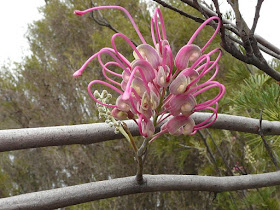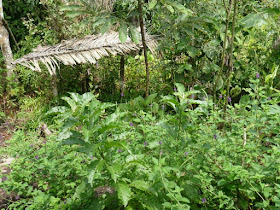In recent times I've begun a sporadic series on the old Gondwanan family Proteaceae, with emphasis on the Australian ones. The most recent one was on Banksias,
which you can see here if you missed it. (I actually fear I'm tempting fate by even mentioning that posting, let alone linking to it. On that occasion, for the first time I failed to post on the promised date, due to the appearance of an unexpected White-winged Black Tern in Canberra. I duly completed the post the next day, and in less than 24 hours I was in the hospital emergency department; however it is quite likely the three events were unrelated so I'll take a chance...)
 |
Fern-leaf Grevillea Grevillea pteridifolia, Normanton, Gulf Country, north Queensland.
A magnificent species, found across tropical Australia - as we shall see, not all grevilleas have flowers in spikes.
This was one of the first grevilleas collected by science; Banks took specimens while Captain Cook's Endeavour
was being repaired after striking the Great Barrier Reef where Cooktown now stands in tropical Queensland. |
Grevillea is one of the most-cultivated genera in Australia, especially due to numerous cultivars. The name of the genus, along with others of the family, was the subject of one the most vitriolic botanical scandals of the 19th century. In 1809 the great Scottish botanist Robert Brown, who had sailed on the Investigator expedition with Matthew Flinders and spent years collecting Australian plants, presented to the Linnaean Society of London a landmark paper on the family Proteaceae, which he was in the process of preparing for publication. Among the audience on the day was botanist Richard Salisbury; he was Honorary Secretary of the Horticultural Society, but proved himself not at all honorable.
A little later that year Joseph Knight, gardener to the plant dealer George Hibbert, published a snappily-titled paper called On the cultivation of the plants belonging to the natural order of Proteeae. However, only 13 pages were dedicated to his cultivation tips; the other 100 comprised a detailed plagiarisation by Salisbury of Brown's names. He didn't use his name and Knight got the 'credit' for the stolen names. However everyone knew it was Salisbury's work and he was widely ostracised and people stubbornly referred the names to Brown when he formally published them in 1810. Brown's task was made even easier when Knight/Salisbury misspelt Grevillea as Grevillia! Finally, a century later, the botanical world introduced the concept of Conserved Names, which enabled them to put aside the strict rules if there was good reason to do so. Today Grevillea is officially described as R. Br. [ie Robert Brown] ex Knight.
 |
White Grevillea G. parallela, Undara National Park, inland north Queensland.
This is another of the species collected at Cooktown. |
The early history of grevilleas (bearing in mind that the name itself didn't appear until 1810) is confusing - to me, anyway!
It seems that Banks and Solander collected some grevilleas at Botany Bay in 1770, including what we now know as
Grevillea mucronulata. Later they collected three more in north Queensland (see the captions above). However the first three grevilleas to be cultivated in England before 1800 were none of these, and were apparently sent to Banks and some nurserymen by
William Paterson, an army officer whose passion was plants.
 |
Silky Grevillea Grevillea sericea, Goulburn River NP, New South Wales.
This was one of the three species received, grown and named in England in the 1790s. |
However, the type species - the first one to be formally named - is a relatively obscure species from around the southern Blue Mountains, G. apleniifolia, not named until 1809! The answer, as I understand it, is that it was described by Knight (fronting for Salisbury), as the first species described as Grevillea. The genus name honours Charles Francis Greville, a friend of Banks and with him a member of the delightfully named Society of Dilettanti (whose passion was the art of ancient Greece and Rome). Greville was a keen gardener, growing tropical species under glass. He had a very close relationship with Emma Hart, who later progressed to being Lord Nelson's lover, but he had no discernible relationship with Australia or grevilleas.
And with that, perhaps we should talk about some plants.... There are some 360 species of Grevillea, of which only 7 are found beyond Australia (in New Guinea, New Caledonia and Sulawesi). Around half of these are found in south-western Australia, one of the world's great botanical hot spots. Most are shrubs, but there are both trees and ground covers.
 |
Beefwood Grevillea striata, Maryvale Road, central Australia.
This is a substantial tree of the central deserts. |
Foliage may be simple or compound, relatively soft or hard and spiky.
 |
| Grevillea bipinnatidifida John Forrest NP, near Perth, Western Australia. |
 |
| Grevillea barklayana, Ulladulla, south coastal New South Wales. |
 |
| Grevillea armigera Reynoldson Flora Reserve, south-western Western Australia. |
Flowers are paired, but as they are in racemes this is not always obvious. Unusually, the pollen-bearing anthers are attached to the inside of the floral tube; the styles are initially trapped inside the tube, with the stigma in contact with the pollen. When the flowers open as the tube segments fold back, the style springs out to present the pollen. Shortly afterwards it becomes a pollen receptor, the only role it plays in most plants.
 |
Honeysuckle Grevillea G. juncifolia, central Australia, above;
Comb-leaf Grevillea G. pectinata, Salmon Gums, Western Australia, below.
In both we can clearly see the older flowers with extended styles, while in unopened flowers the
styles are still trapped within the tube.
Mostly in racemes the older flowers are at the base (as above) as the tip continues to grow,
but there is no such evident pattern in the photo below. |
|
Sometimes the racemes are short with relatively few flowers.
 |
| Grevillea alpina, Micalong Falls west of Canberra. |
 |
| Rusty Grevillea, or (my favourite) Seven Dwarfs Grevillea G. floribunda,Goobang NP, New South Wales. |
Elongated racemes may be 'toothbrush' types, with the flowers all on one side, or bottlebrush type with the flowers all round the stem.
 |
Grevillea cageana, Southern Cross, inland southern Western Australia, above;
Grevillea excelsior, Hyden-Norseman Road, similar area, below.
These are both toothbrush types; see also several examples above. |
 |
Grevillea candelabroides, Kalbarri NP, Western Australia.
'Like a candelabra' is an excellent description in the species name!
This, and the next two, are examples of bottlebrush-type racemes. |
 |
| Grevillea paradoxa, Ballidu, south-western Western Australia. |
 |
| Grevillea petrophiloides, Kalbarri NP, Western Australia. |
A few species, with small white flowers, are insect-pollinated, but most rely on birds.
 |
Grevillea biternata, Gawler Ranges NP, South Australia.
See also the Common Crow butterfly on the G. parallela in the photo above. |
 |
| Dusky Honeyeater Myzomela obscura, on Grevillea cultivar, Darwin. |
 |
Grey-headed Honeyeater Lichenostomus keartlandi) on Grevillea wickhamii,Kings Canyon, central Australia.
|
I hope you've enjoyed this brief visit to the wonderful world of grevilleas as much as I have; my thanks for your company. Perhaps just a few more to finish with...
 |
Desert Grevillea G. eriostacha Kalbarri NP, Western Australia.
A magnificent sight when flowering on red sand dunes. |
 |
Woolly Grevillea G. lanigera, Namadgi National Park, near Canberra.
A low shrub growing beneath the Snow Gums. |
 |
| Grevillea pinaster, South Beekeepers Nature Reserve, south-west Western Australia. |
 |
Sandhill Grevillea G. stenobotrya, near Windorah, south-west Queensland.
Another beautiful desert grevillea of the red sand dunes. |
BACK ON WEDNESDAY

























































